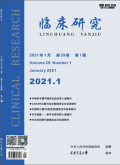临床研究2024,Vol.32Issue(1):1-4,4.DOI:10.12385/j.issn.2096-1278(2024)01-0001-04
新生儿三代头孢菌素耐药肺炎克雷伯菌感染的危险因素研究
Study on Risk Factors of Third-generation Cephalosporin-resistant Klebsiella Pneumoniae Infection in Newborns
摘要
Abstract
Objective To analyze the risk factors of third-generation cephalosporin-resistant Klebsiella pneumoniae infection in children in the intensive care unit(ICU)in this region.Methods The distribution and antimicrobial resistance of Klebsiella pneumoniae clinically isolated from the neonatal department of Zhengzhou Maternal and Child Health Hospital from June 2017 to June 2023 were retrospectively analyzed,and the children were grouped according to their drug susceptibility.Children infected with three generations of cephalosporin-resistant Klebsiella pneumoniae(38 cases)were enrolled as the resistant group,and children infected with three generations of cephalosporin-sensitive Klebsiella pneumoniae(100 cases)were enrolled as the sensitive group.The clinical data of all subjects in the included groups were collected,including sex ratio,birth age(<3/≥3 d),delivery mode(vaginal delivery/cesarean section),premature delivery,length of hospital stay(<7 d/≥7 d),duration of mechanical ventilation(<5 d/≥5 d),history of catheterization,and history of carbapenem antibiotics use.The difference in clinical data between the two groups was compared,and the difference items were calculated by a Logistic regression equation to analyze the risk factors of third-generation cephalosporin-resistant Klebsiella pneumoniae infection in children in neonatal ICU.Results There was no significant difference in gender,age of birth,and mode of delivery between the drug-resistant group and the sensitive group(P>0.05).There were statistically significant differences in preterm birth,length of hospital stay,duration of mechanical ventilation,history of catheterization,and history of carbapenem antibiotics use between the two groups(P<0.05).The Logistic regression equation showed that preterm birth,hospitalization time≥7 days,mechanical ventilation time≥5 days,history of catheterization,and history of carbapenem antibiotics use were risk factors for third-generation cephalosporine resistant Klebsiella pneumoniae infection in children-in-neonatal-ICU.Conclusion The risk factors for third-generation cephalosphaero-resistant Klebsiella pneumoniae infection in children in neonatal ICU mainly include premature birth,hospital stay≥7 days,mechanical ventilation time≥5 days,history of catheter placement,and history of carbapenem treatment.More attention should be paid to pregnant women during hospitalization,and active prevention should be taken to ensure the life safety of newborns.关键词
新生儿/重症监护病房/肺炎克雷伯菌感染/危险因素/碳青霉烯类抗生素Key words
newborn/intensive care unit/Klebsiella pneumoniae infection/risk factors/carbapenem antibiotics分类
临床医学引用本文复制引用
贺小红,王韶..新生儿三代头孢菌素耐药肺炎克雷伯菌感染的危险因素研究[J].临床研究,2024,32(1):1-4,4.基金项目
2019年度河南省医学科技攻关计划联合共建项目(LHGJ20191137). (LHGJ20191137)

